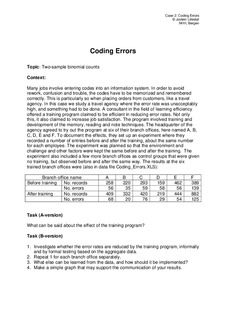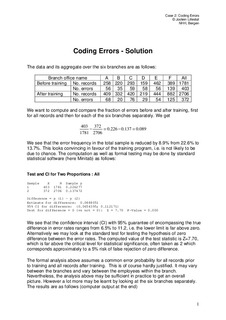| dc.description.abstract | Topic: Two-sample binomial counts
Context:
Many jobs involve entering codes into an information system. In order to avoid rework, confusion and trouble, the codes have to be memorized and remembered correctly. This is particularly so when placing orders from customers, like a travel agency. In this case we study a travel agency where the error rate was unacceptably high, and something had to be done. A consultant in the field of learning efficiency offered a training program claimed to be efficient in reducing error rates. Not only this, it also claimed to increase job satisfaction. The program involved training and development of the memory, reading and note techniques. The headquarter of the agency agreed to try out the program at six of their branch offices, here named A, B, C, D, E and F. To document the effects, they set up an experiment where they recorded a number of entries before and after the training, about the same number for each employee. The experiment was planned so that the environment and challenge and other factors were kept the same before and after the training. The experiment also included a few more branch offices as control groups that were given no training, but observed before and after the same way. The results at the six trained branch offices were (also in data file Coding_Errors.XLS):
Branch office name A B C D E F
Before training No. records 258 220 293 159 462 389
No. errors 56 35 59 58 56 139
After training No. records 409 332 420 219 444 882
No. errors 68 20 76 29 54 125
Task (A-version)
What can be said about the effect of the training program?
Task (B-version)
1. Investigate whether the error rates are reduced by the training program, informally and by formal testing based on the aggregate data.
2. Repeat 1 for each branch office separately.
3. What else can be learned from the data, and how should it be implemented?
4. Make a simple graph that may support the communication of your results. | nb_NO |


